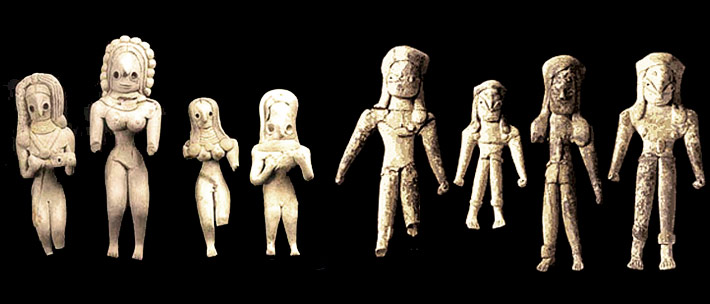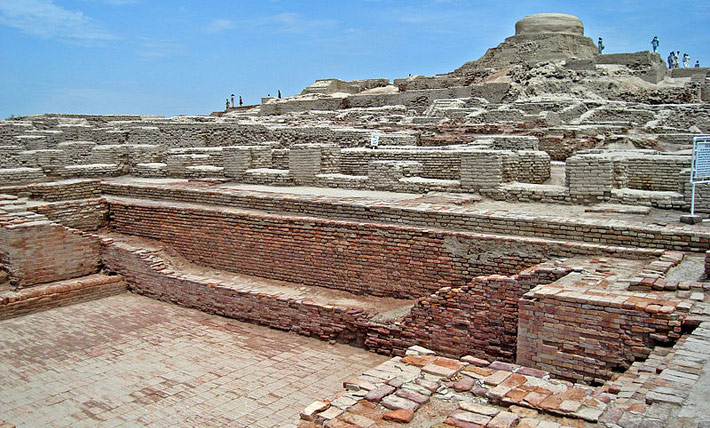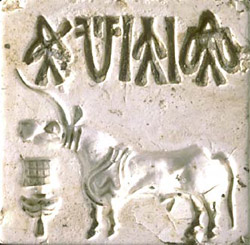
Indus-Sarasvati Civilization:
Mohenjo-Daro 2600–1900 BCE
Mohenjo-Daro was one of the most important cities of the Indus civilization. It was located between the two vast river valleys of the Indus and the Sarasvati in the province of Sindh, Pakistan.

There is no evidence of palaces, temples, or monuments, no obvious central seat of government or evidence of king or queen
Constructed on the build up of occupation debris and massive mud brick platforms, the settlement grew to monumental proportions, with high mounds reaching as high as 12 meters above the modern plain level, and probably much higher above the ancient plain. Its design is similar to other Indus-Sarasvati city sites with streets running in a grid pattern. They vary from 9 feet to 34 feet wide, suitable for wheeled traffic. Larger multi-roomed buildings, often two or three storied were situated on either side of the main streets and may have been for administrative or collective functions, with the smaller two-roomed rectangular dwellings on either side of what might be viewed as lanes. There is no evidence of palaces, temples, or monuments, no obvious central seat of government or evidence of king or queen.
During its prime from about 2500 to 1900 BCE Mohenjo-Daro was one of the most important cities of the Indus civilization with as many as 35,000 inhabitants. It spread out over about 250 acres (100 hectares) on a series of mounds, the Great Bath and an associated large building occupied the tallest mound.
Settlements flourished along the coastline of Northwest India in particular in the Gujarat region. Here the town of Lothal was established around 2400 BCE on a former course of the Sabarmati River, which provided nearby access to the Arabian Sea and maritime trade routes. Here we find the first known dockyard in history connected to a substantial wharf, which lead up to a warehouse. The warehouse consisted of 64 rooms, 3.5 m x 3.5 m, with spacious passageways in between. Many seals have been found in the vicinity that were most likely used to label and denote ownership of goods being processed there.
In the series: Indus-Sarasvati Civilization
Related articles:
- Mesopotamia: “The Land Between Two Rivers”
- Worldview and Beliefs
- Connecting Heaven and Earth
- Early Signs of Monotheism
- The Epic of Gilgamesh & Other Writings
- Understanding Their World
- The Noble Ones
- The Cycladic Civilization Circa 3300 to 1100 BCE
- Minoa – Europe’s First Civilization
- Minoan “Palaces” and Religious Beliefs
- Conflict and Calamity
- The Mycenaeans 1600–1100 BCE
- Archaic Greece: The Dark Age and a New Dawn
- Emerging from the Dark Age 800–500 BCE
- History According to the Storytellers
- Religious Life
- Early Civilizations China
- Three Legendary Sovereigns
- The Five Emperors
- The Shang Dynasty 1600–1045 BCE
- Neolithic Era: Cosmic and Terrestrial Maintenance
- Death and Transcendence
- Replicating the Cave Experience
- Beliefs and Customs Journey West
- Temples of Malta – A Scientific Breakthrough
- A Mega Building Boom as the Era Ends
- Pyramids: Stairway to the Gods
- Mesopotamia: “The Land Between Two Rivers”
- Worldview and Beliefs
- Connecting Heaven and Earth
- Early Signs of Monotheism
- The Epic of Gilgamesh & Other Writings
- Understanding Their World
- The Noble Ones
Further Reading
External Stories and Videos

Aryan Migration: Everything You Need to Know About the New Study on Indian Genetics
Rohan Venkataramakrishnan, Scroll.in
The study says some sort of migration did indeed take place into India and that the Indus Valley civilization is key to all South Asian populations.

Harappa.com
Explore the ancient Indus Valley civilization through slideshows, essays and articles from leading scholars from India, Pakistan, US, and Europe.

